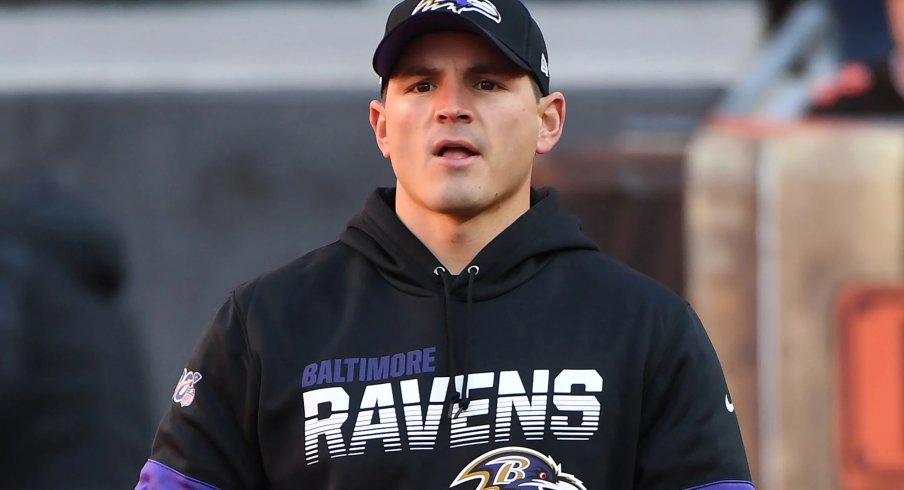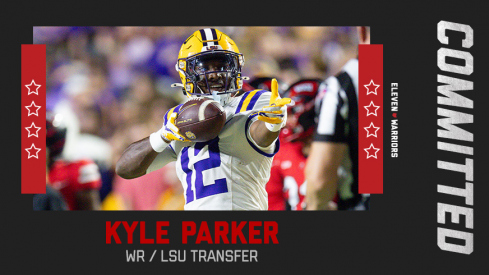After five relatively successful seasons in Ann Arbor, Don Brown was painted as the sacrificial lamb and dismissed over the winter, following a season unlike any other. Despite finishing among the top 10 nationally in total defense every year prior, Brown was let go after the Wolverines dropped to 56th in the category last season.
But while Jim Harbaugh's defense was struggling to keep its head above water, his brother's was sitting near the top of the NFL's ranking yet again. In 2020, John Harbaugh's Ravens finished second in points allowed and seventh in both total yards-allowed and yards-per-play allowed.
Through that lens, it's not surprising that Jim might look to his older brother for advice when searching for a new leader of his defense. The result was the hiring of a 34-year-old coach with zero years of experience calling plays, but who has spent the past decade learning from some of the best minds in the game.
| Year(s) | Team (Position) |
|---|---|
| 2010 | Georgia (GA) |
| 2011-13 | Georgia (Quality Control) |
| 2014 | Baltimore Ravens (Intern) |
| 2015-16 | Baltimore Ravens (Def. Asst) |
| 2017 | Baltimore Ravens (DBs) |
| 2018-20 | Baltimore Ravens (LBs) |
| 2021 | Michigan (DC) |
Mike MacDonald began his career as a graduate assistant at his alma mater, the University of Georgia, earning a spot as the defensive quality control assistant on Mark Richt's staff. But the young coach's real education came in 2014 when he transitioned to the professional game and joined the staff in Baltimore.
Beginning as an intern and eventually working his way to becoming a position coach for the Ravens' defensive backs, and later the linebackers, MacDonald had the chance to work directly with a trio of Pro Bowlers in safety Eric Weddle and linebackers C.J. Mosley and Matthew Judon.
During that period, MacDonald had the chance to learn from legendary NFL coordinator Dean Pees, who led the Baltimore defense from 2012-2017. Pees, a native of Dunkirk, OH holds a resume featuring stops at the University of Findlay, Miami, Toledo, and Kent State before eventually leading Bill Belichick's New England defense in the late 2000s.
While working in Foxboro, Pees adopted Belichick's revolutionary style of adapting his team's look each week to match the style of each week's opponent, shedding the traditional label of being a 4-3 or 3-4 team. Eventually, Pees moved on to Baltimore, where he'd spend nearly a decade implementing a similar system for John Harbaugh's team, helping him secure a Super Bowl victory over the younger Harbaugh's 49ers in 2013.
After Pees' retirement in 2018, John turned to his top assistant: then-linebackers coach Don 'Wink' Martindale. The Dayton native also began his career in the Buckeye state, with stops at Defiance College and Cincinnati before eventually making his way to the NFL.
When taking over for Pees, Martindale maintained Pees' philosophy of using multiple personnel groups and formations, but added a dose of extra dynamism, sending Ravens defenders on blitzes more than anyone else in the league. It was at this point, in 2018, that MacDonald became one of Martindale's top assistants and adopted the philosophy for himself.
"We're going to be multiple," MacDonald told the media in his introductory press conference as the Wolverines' new defensive coordinator this spring. "The best way I can describe our scheme is it's going to look a lot like the places I've been previously. If you watch our Baltimore defense, tell me the times it looked like a 3-4. There's going to be a certain percentage there, but there's a lot of times where we're going to look like a 4-3, there are some times where we're going to look like a 6-1, some times we'll look like a 6-2, and some times you're not going to know what the heck it looks like."
One need not look very hard to see what he means. In the Ravens' opening game last fall, they came out against the Browns playing with three down linemen, two 'edge' outside linebackers, and three effective inside linebackers as strong safety Chuck Clark dropped down into the box.
The look was effectively a 5-3 defense meant to stifle the Browns' physical running game. One week later, though, the Ravens based out of a 4-2-5 look against Deshaun Watson and the spread-option offense of the Houston Texans.

As noted, however, the Ravens' success came not only from its varied alignments, but what came from them. As Seth Galina of Pro Football Focus summarized, "[The Ravens] are going to blitz every chance they get and play man coverage on the back end."
With Pro Bowl corners like Marlon Humphrey and Marcus Peters at his disposal, it's no wonder Martindale leaned heavily on such coverage concepts, leaving the two lockdown players alone outside while packing the middle of the field. According to PFF, the Ravens played the duo in man-coverage just under 50% of the time, one of the highest-such marks in the league.
But the Ravens were no slouches when dropping into zone, either. By PFF's grading system, Humphrey was the top-rated corner in the league last year when playing zone, giving Martindale plenty of flexibility when designing his weekly game plans.
The result was an aggressive approach that sought to confuse and overwhelm opponents by appearing to send pressure from all angles while relying on a superior secondary to blanket receivers behind it. The Ravens rarely just lined up in a static look, often crowding the line of scrimmage and clouding the offense's view of their intentions when running even the most basic of calls.
As has long been the case with teams that 'base' out of a 3-4 look, the Ravens playbook features a plethora of zone blitzes that seeks to confuse not only quarterbacks but their protectors as well.
In this example, we see two defenders creep up to the line pre-snap, giving the impression that they'll bring pressure through the middle, only to drop back in coverage after the snap. In their place, however, came the middle linebacker through the opposite side.
While the initial blitz wasn't enough to break the pocket, it caused the QB to panic and scramble instead of making a throw, resulting in only a short gain.
Creating such chaos is the hallmark of Martindale's defense, as he consistently found ways to beat one side of the pocket by sending an extra rusher. However, he often balanced that aggression by dropping defenders back into coverage and leaving one-half of the offensive line looking around for someone to block.
For instance, on the opening possession of the 2020 campaign, the Ravens showed pressure along the entire line as the Browns faced a daunting 3rd & 10 near midfield. After initially lining up with two high safeties, the free safety (#32) creeps up behind the right edge rusher, giving the offense seven bodies to account for as potential pass rushers.
Upon the snap, the four defenders along the right run a looping stunt that the Browns do a decent job of picking up. However, the action forces quarterback Baker Mayfield to look for his hot read, a quick slant right behind the pressure.
What Mayfield doesn't see, though, is the rushers from the opposite side all dropping into three underneath zones in the defense's Cover 4 Quarters zone. All 6'7" of massive, do-everything defensive end Calais Campbell (#93) was able to drop into Mayfield's passing window just quickly enough to get his huge paw on the pass, tipping it up for the zone-dropping Humphrey to fall under it and create a turnover.
Attacking the weak link in a pass protection is Martindale's specialty. According to PFF, Baltimore has created unblocked pressure on 177 snaps over the past two seasons, 37 more than the next best team over that span.
Instead of thinking about the pocket in its entirety and trying to rush seven defenders against six blockers, the Ravens try to isolate individual blockers and send two rushers where only one can be picked up. As seen below, Martindale found a way to create a 3-on-2 that resulted in a free rusher while still dropping seven defenders in coverage.
“Our goal is to try to put as much stress on protection rules that teams have,” Martindale said during the 2019 season. “And the end-all goal is to have a free runner to the quarterback. But what you’re seeing is anybody that comes off the bus can blitz for us, and they know that.
By showing three rushers on either of the pocket, Martindale knew the Browns would split their assignments in half with the center helping the right guard and tackle since the tight end was there to help along the left.
Except the tight end was one of the offense's likely pass targets on this 2nd & long play and would be in a hurry to get open downfield rather than help protect his QB. So, Martindale gambled by sending pressure to that side before the center could realize the pressure was coming from the other way, resulting in a sack.
In Ann Arbor, MacDonald won't have quite the same level of talent he's been used to, especially at cornerback. Humphrey and Peters are two of the NFL's best, which allowed the Ravens to pack the field between the numbers.
But even if the Wolverines play more zone than the Ravens, MacDonald will still have a bevy of blitzes to throw at opponents. By lining up preseason All-Big Ten selection Aidan Hutchinson all over the defensive line, much as the Ravens have done with Campbell, MacDonald will likely try to dictate the action along the line of scrimmage in ways not seen under his predecessor
“It’s going to be very much tailored to who can do what and the guys that we have on the roster,” Macdonald said. “That’s why it’s hard for me to tell you what it’s going to be because we do have different players and different skill sets than places I’ve been in the past. But the principles are the same in terms of how you play and how you build out a defense."
Brown was known for his philosophy, "solve your problems with aggression." While the schemes he used to apply that concept are somewhat different than the ones MacDonald is currently installing, the underlying sentiment remains the same. Like the Ravens, we can expect the Wolverine to blitz, and blitz, and blitz some more come this fall.
Will it work? We'll just have to wait and see.



